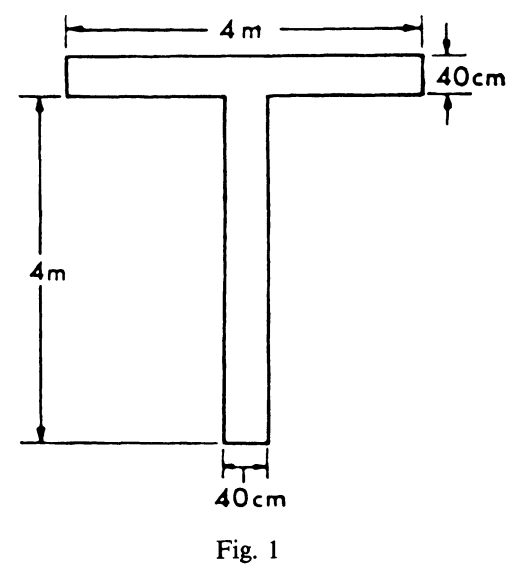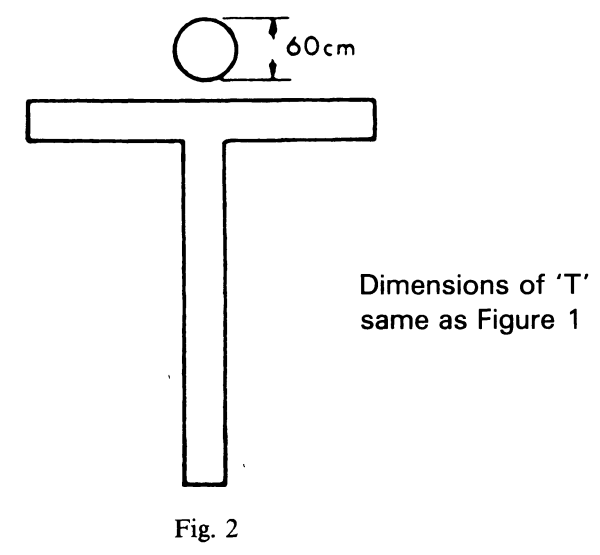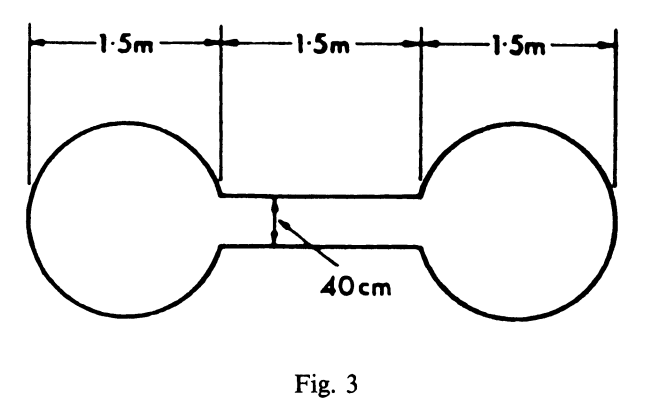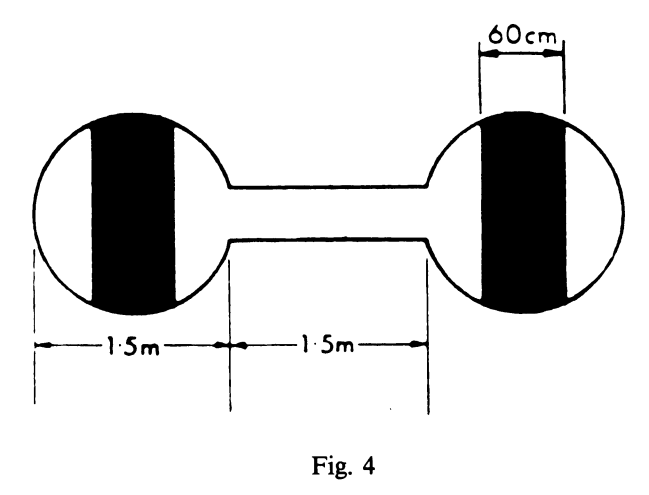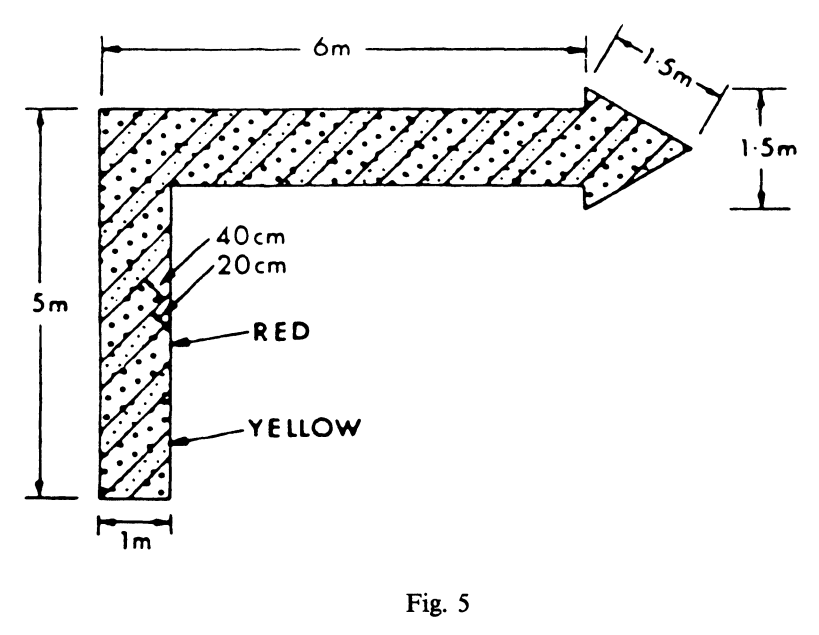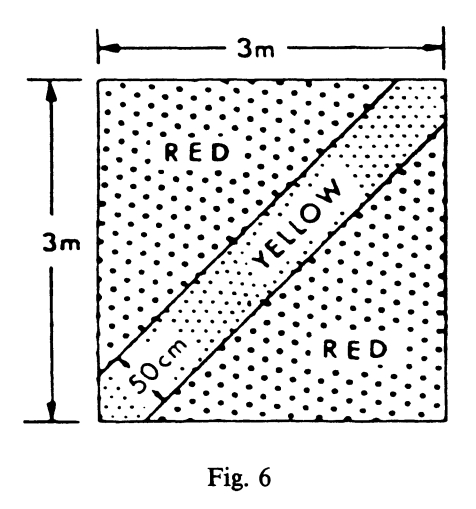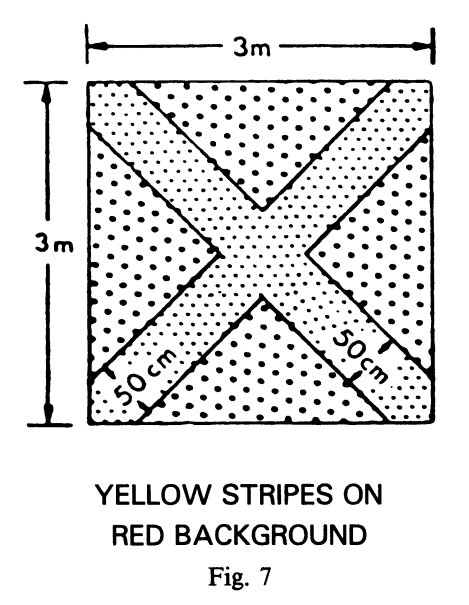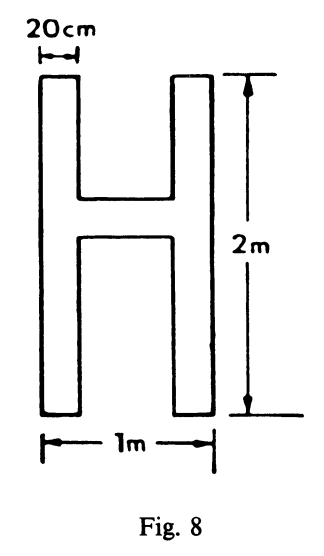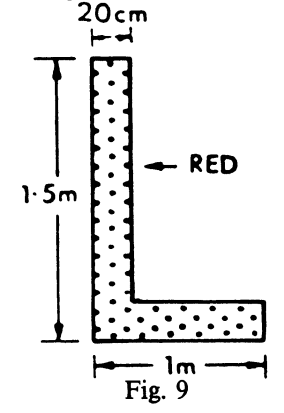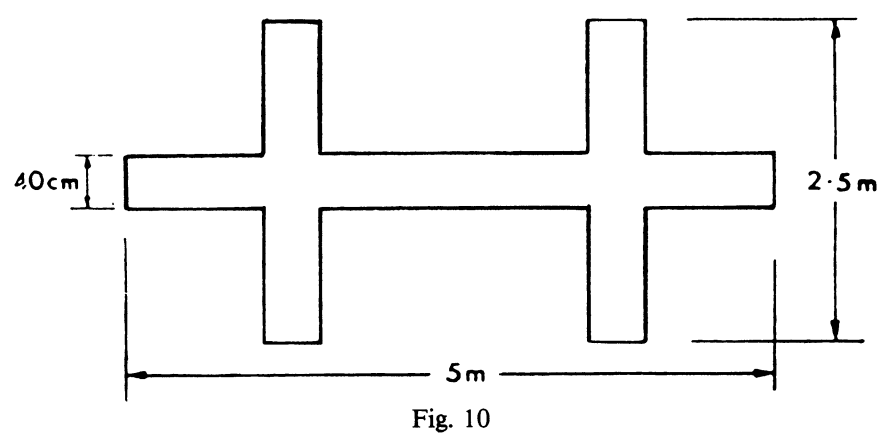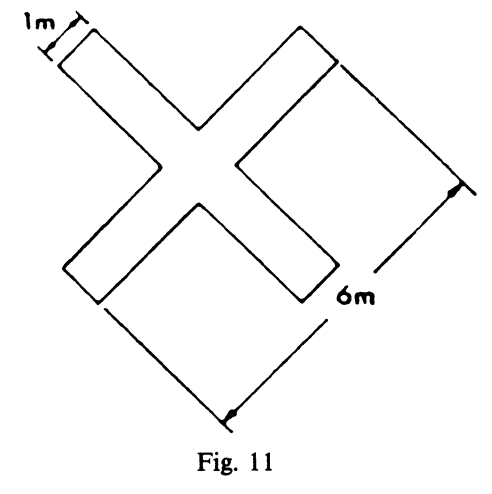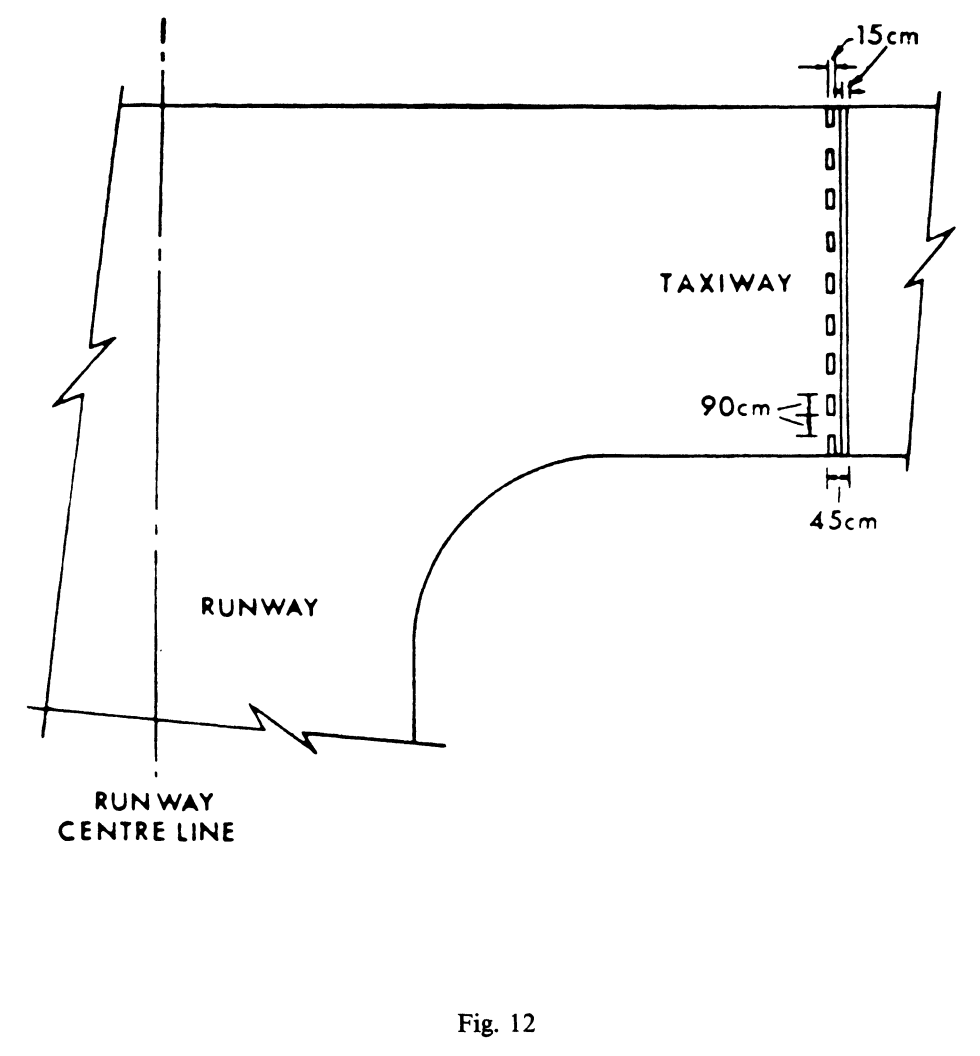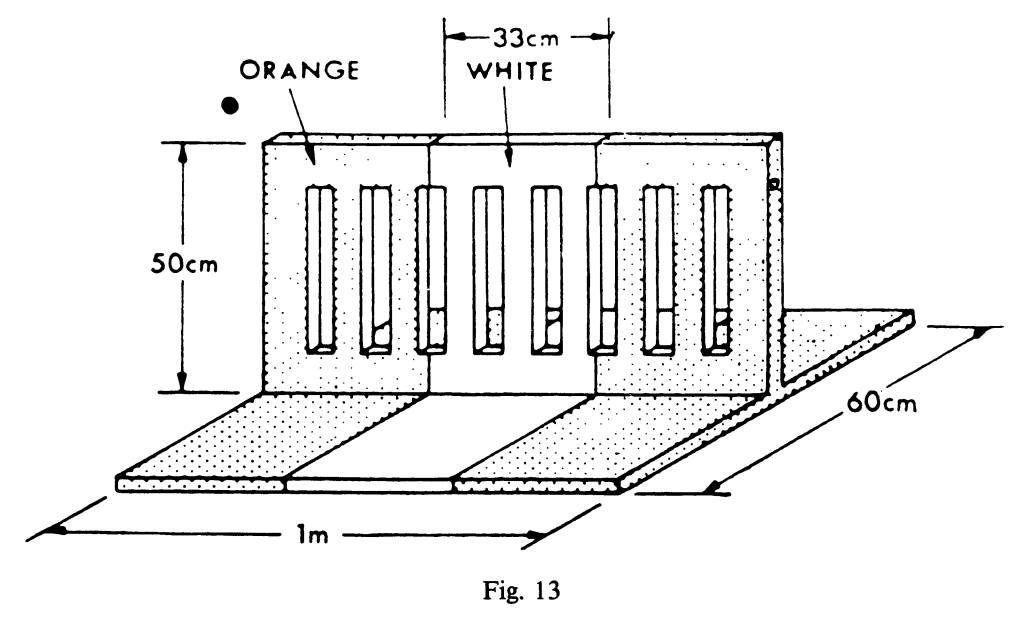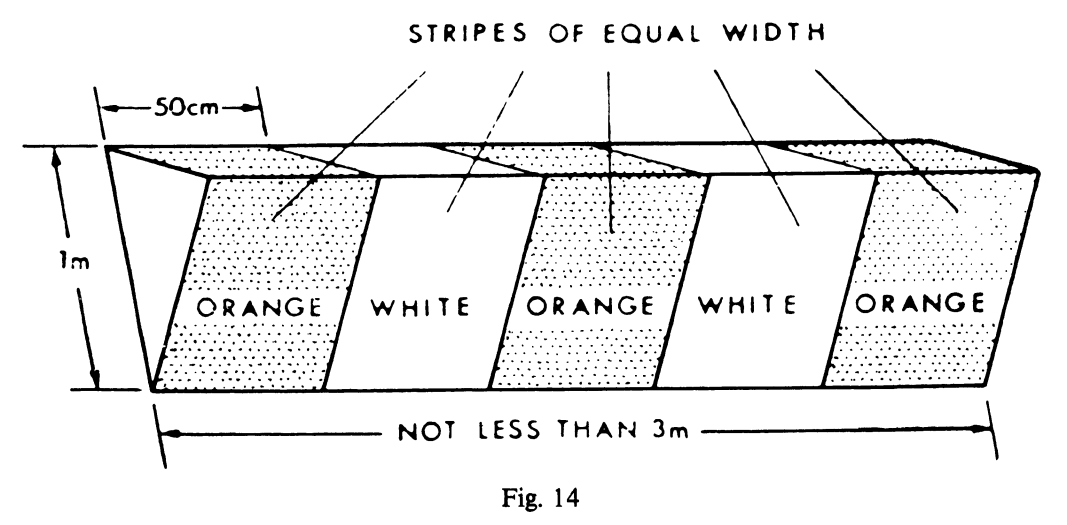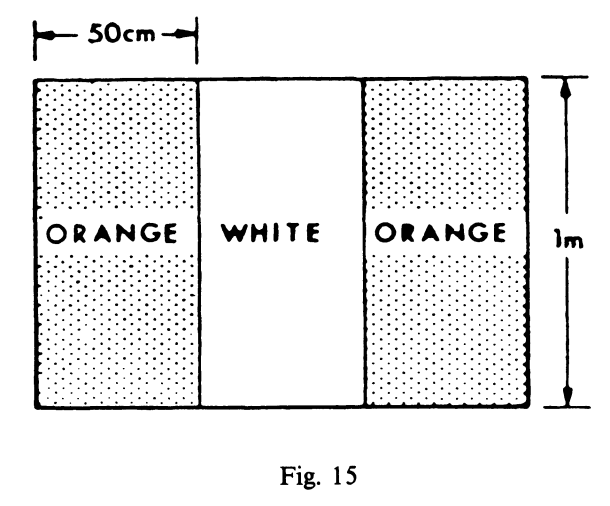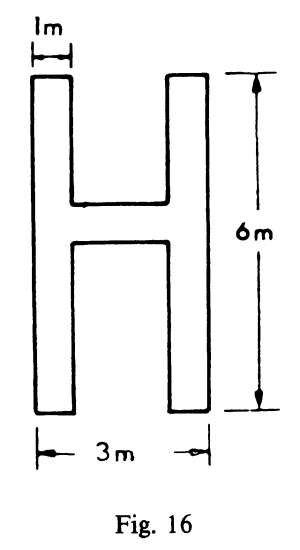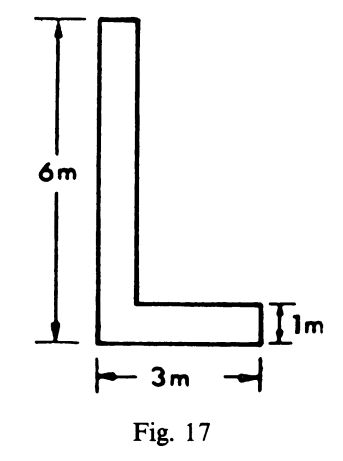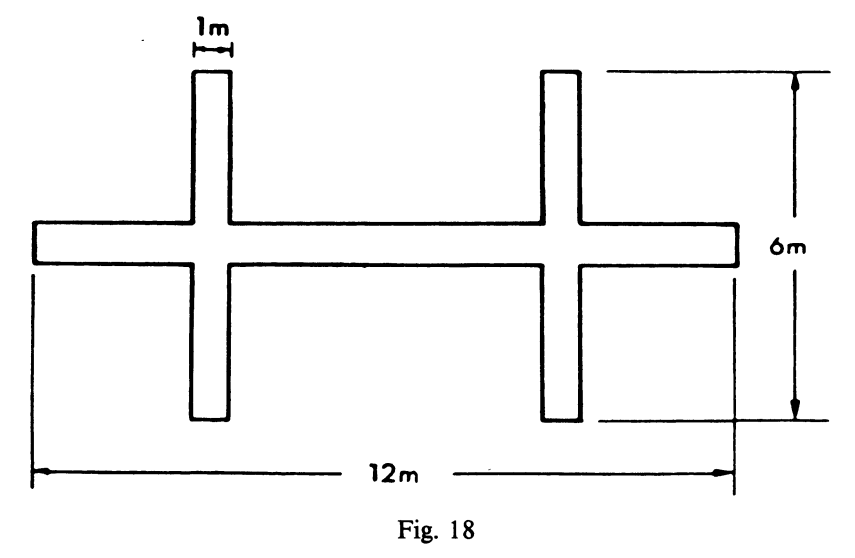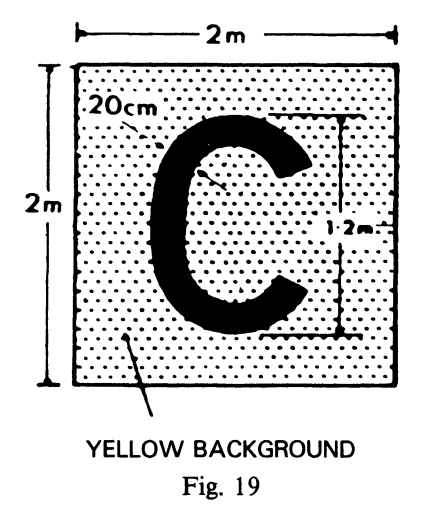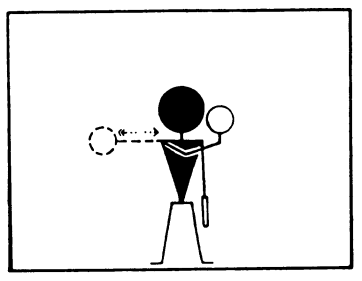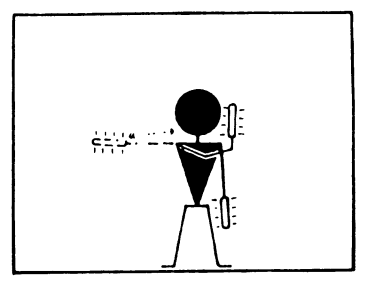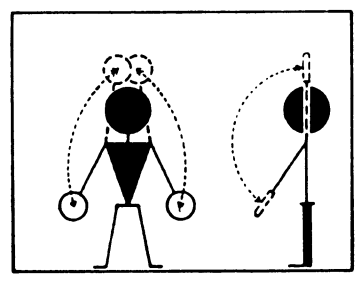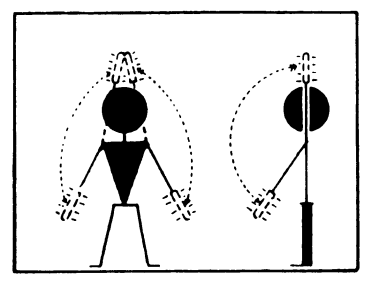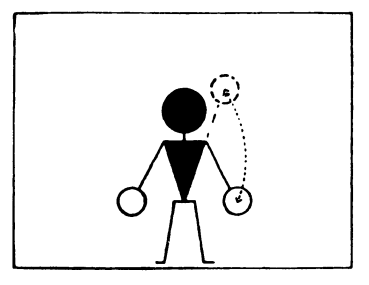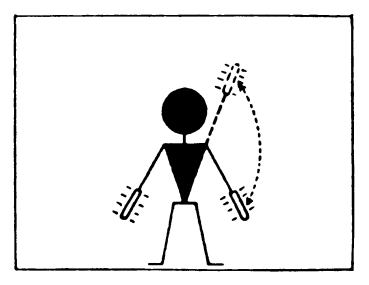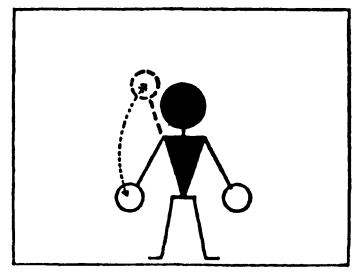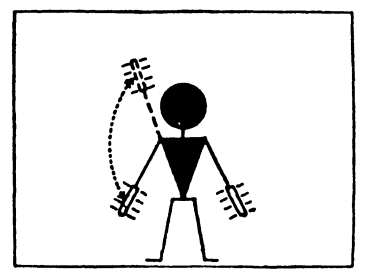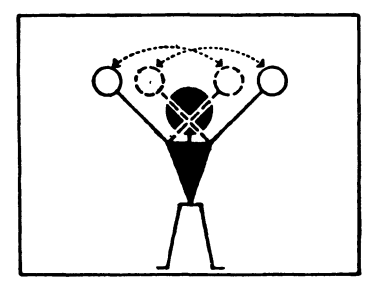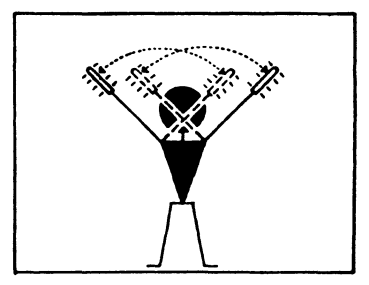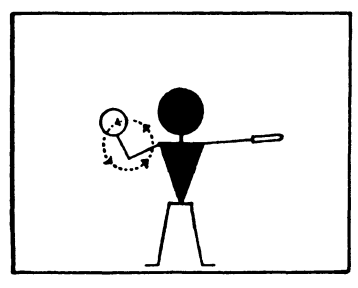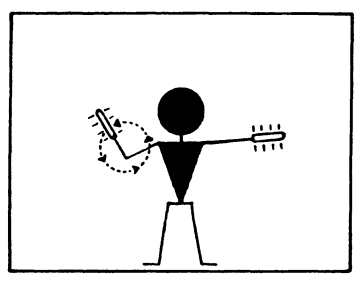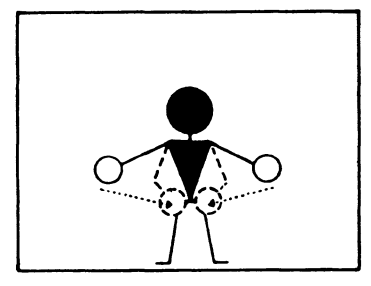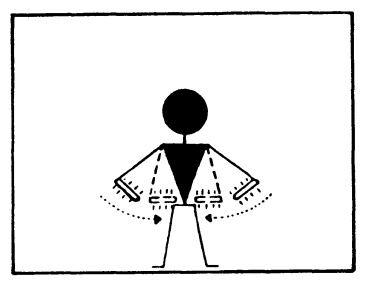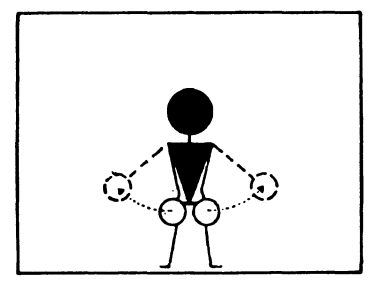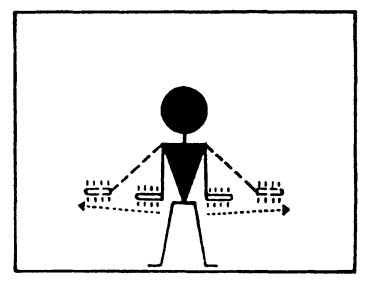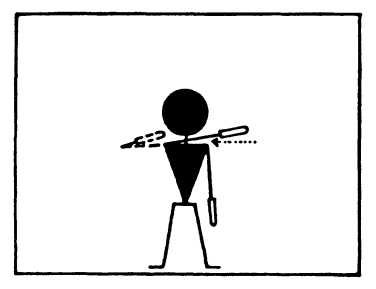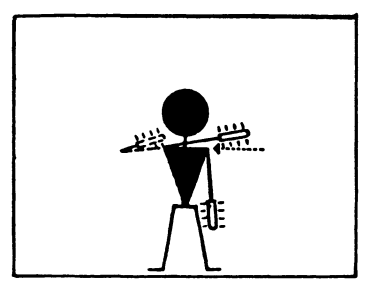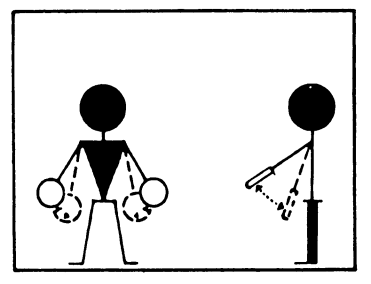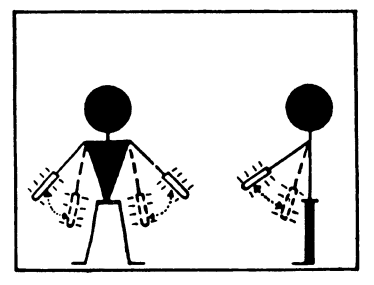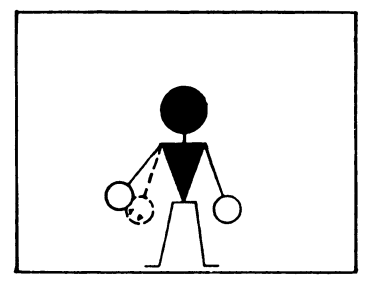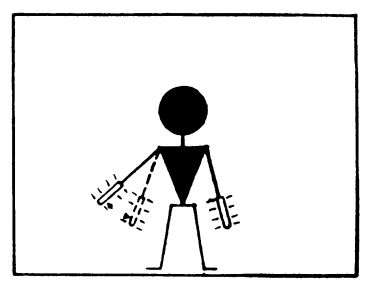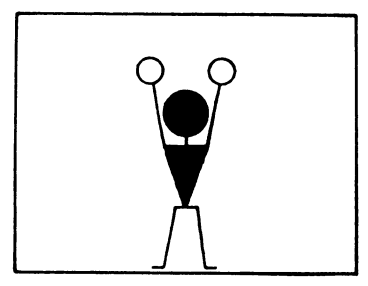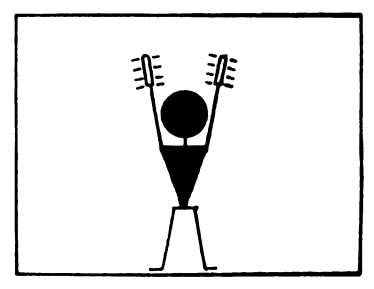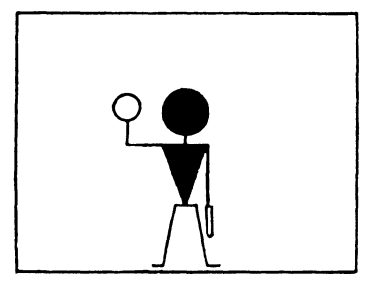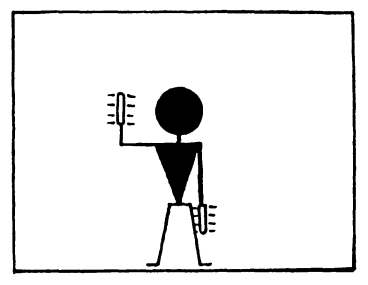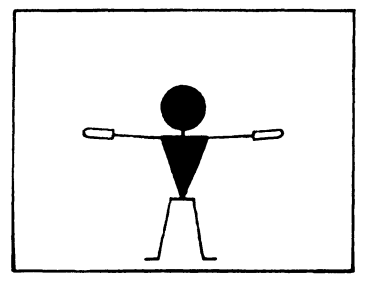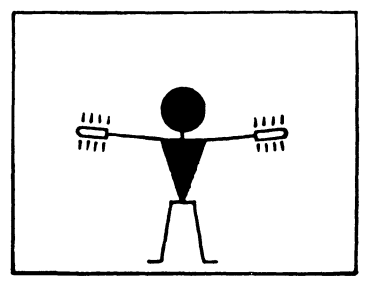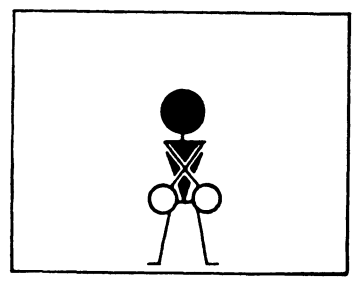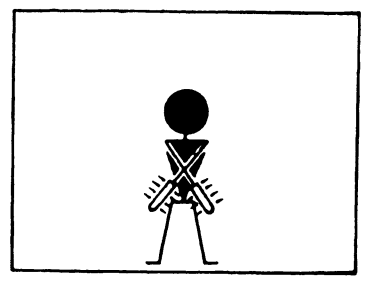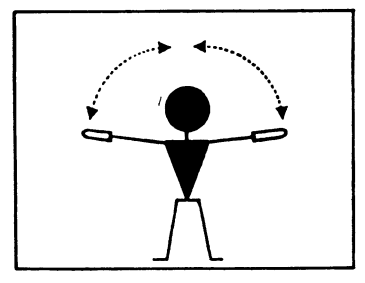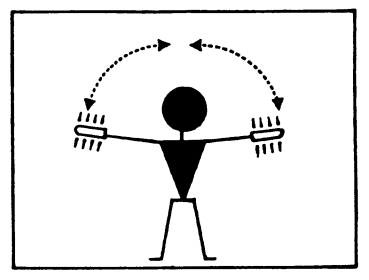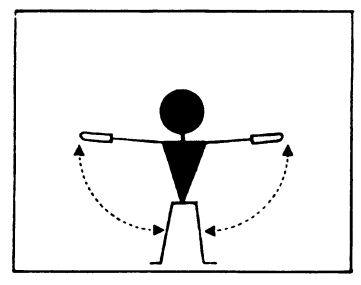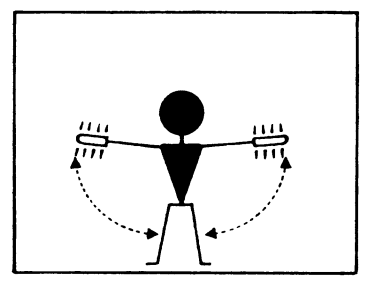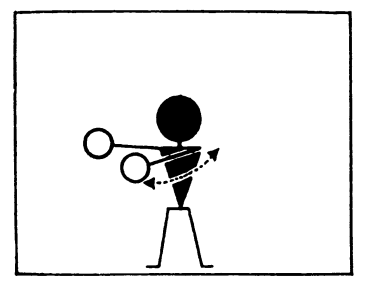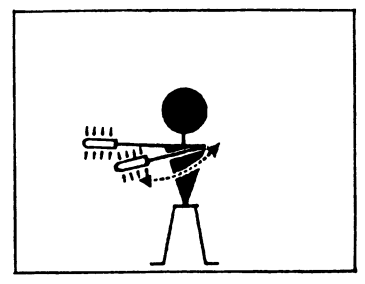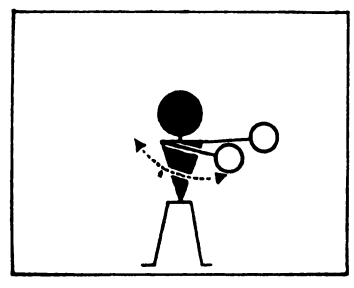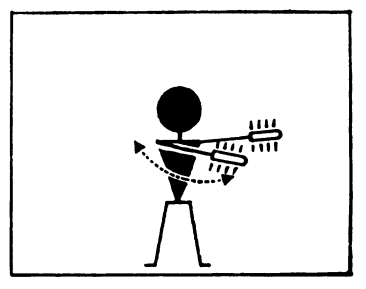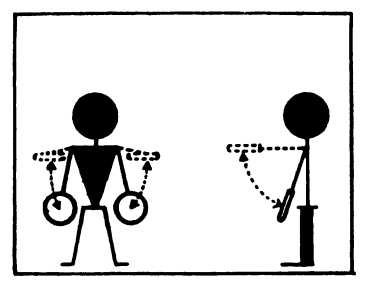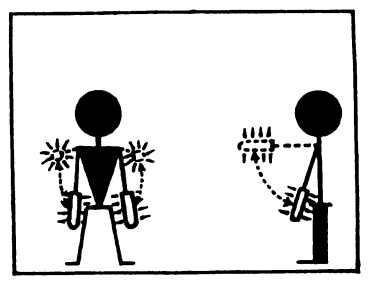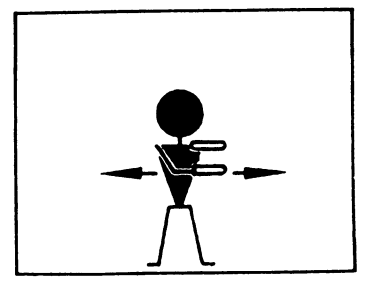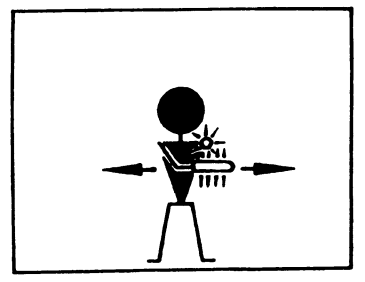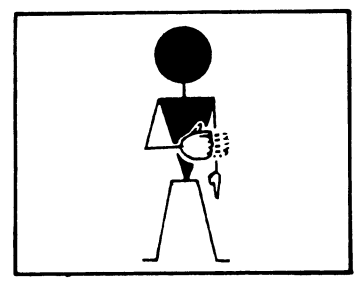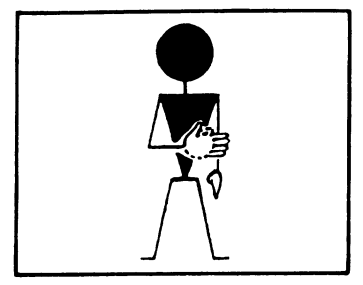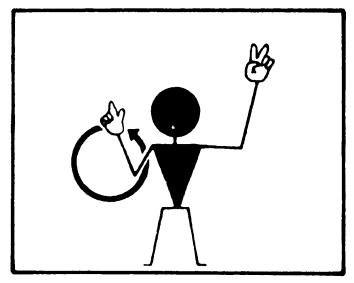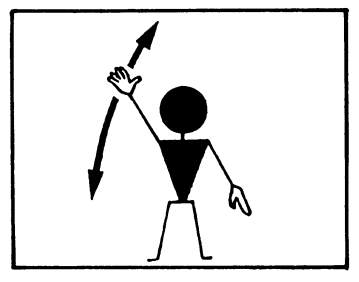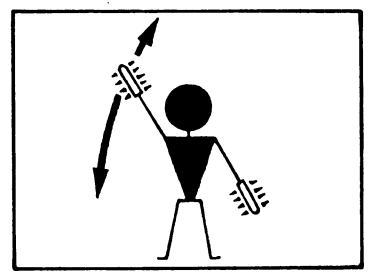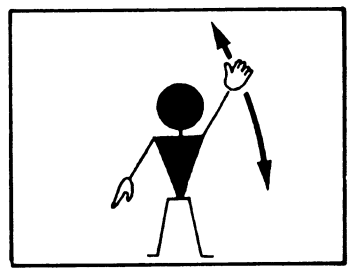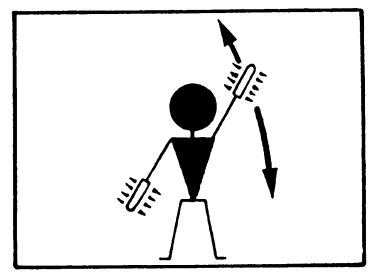SCHEDULE 13RULES OF THE AIR AND AIR TRAFFIC CONTROL
SECTION VIIIAERODROME SIGNALS AND MARKINGS; VISUAL AND AURAL SIGNALS
General
37.—(1) Whenever any signal specified in this Section of these Rules is given or displayed, or whenever any marking so specified is displayed, by any person in an aircraft, or at an aerodrome, or at any other place which is being used by aircraft for landing or take-off, it shall, when given or displayed in the Territory, have the meaning assigned to it in this Section.
(2) All dimensions specified in this Section of these Rules shall be subject to a tolerance of 10 per cent, plus or minus.
Signals in the signals area
38.—(1) When any signal specified in the following paragraphs of this Rule is displayed it shall be placed in a signals area, which shall be a square visible in all directions bordered by a white strip 30 centimetres wide the internal sides measuring 12 metres.
(2) A white landing T, as illustrated in this paragraph,
signifies that aeroplanes and gliders taking off or landing shall do so in a direction parallel with the shaft of the T and towards the cross arm, unless otherwise authorised by the appropriate air traffic control unit.
(3) A white disc 60 centimetres in diameter displayed alongside the cross arm of the T and in line with the shaft of the T, as illustrated in this paragraph,
signifies that the direction of landing and take-off do not necessarily coincide.
(4) A white dumb-bell, as illustrated in this paragraph,
signifies that movements of aeroplanes and gliders on the ground shall be confined to paved, metalled or similar hard surfaces.
(5) A white dumb-bell as described in (4) above but with a black strip 60 centimetres wide across each disc at right angles to the shaft of the dumb-bell, as illustrated in this paragraph,
signifies that aeroplanes and gliders taking off or landing shall do so on a runway but that movement on the ground is not confined to paved, metalled or similar hard surfaces.
(6) A red and yellow striped arrow, as illustrated in this paragraph,
the shaft of which is at least one metre wide placed along the whole or not less than a total of 11 metres of two adjacent sides of the signals area and pointing in a clockwise direction signifies that a right-hand circuit is in force.
(7) A red panel 3 metres square with a yellow strip along one diagonal at least 50 centimetres wide, as illustrated in this paragraph,
signifies that the state of the manoeuvring area is poor and pilots must exercise special care when landing.
(8) A red panel 3 metres square with a yellow strip, at least 50 centimetres wide, along each diagonal, as illustrated in this paragraph,
signifies that the aerodrome is unsafe for the movement of aircraft and that landing on the aerodrome is prohibited.
(9) A white letter H, as illustrated in this paragraph,
signifies that helicopters shall take off and land only within the area designated by the marking specified in Rule 40(5) of these Rules.
(10) A red letter L displayed on the dumb-bell specified in paragraph (4) and (5) of this Rule, as illustrated in this paragraph,
signifies that light aircraft are permitted to take off and land either on a runway or on the area designated by the marking specified in Rule 40(6) of these Rules.
(11) A white double cross, as illustrated in this paragraph,
signifies that glider flying is in progress.
Markings for Paved Runways and Taxiways
39.—(1) Two or more white crosses, as illustrated in this paragraph,
displayed on a runway or taxiway, with the arms of the crosses at an angle of 45° to the centre line of the runway, at intervals of not more than 300 metres signify that the section of the runway or taxiway marked by them is unfit for the movement of aircraft.
(2) A white broken line and a continuous line, as illustrated in this paragraph,
signify a holding position beyond which no part of an aircraft or vehicle shall project in the direction of the runway without permission from an air control unit.
(3) Orange and white markers, as illustrated in this paragraph,
spaced not more than 15 metres apart, signify the boundary of that part of a paved runway, taxiway or apron which is unfit for the movement of aircraft.
Markings on unpaved manoeuvring areas
40.—(1) Markers with orange and white stripes of an equal width of not less than 50 centimetres, with an orange stripe at each end, as illustrated in this paragraph,
alternating with flags not less than 60 centimetres square showing equal orange and white triangular areas, indicate the boundary of an area unfit for the movement of aircraft and one or more white crosses as specified in Rule 39(1) of these Rules indicate the said area. The distance between any two successive orange and white flags shall not exceed 90 metres.
(2) Striped markers, as specified in paragraph (1) of this Rule, spaced not more than 45 metres apart, indicate the boundary of an aerodrome.
(3) On structures, markers with orange and white vertical stripes, of an equal width of not less than 50 centimetres, with an orange stripe at each end, as illustrated in this paragraph,
spaced not more than 45 metres apart, indicate the boundary of an aerodrome. The pattern of the marker shall be visible from inside and outside the aerodrome and the marker shall be affixed not more than 15 centimetres from the top of the structure.
(4) White flat rectangular markers 3 metres long and 1 metres wide at intervals not exceeding 90 metres, flush with the surface of the unpaved runway or stopway, as the case may be, indicate the boundary on an unpaved runway or of a stopway.
(5) A white letter H, as illustrated in this paragraph,
indicates an area which shall be used only for the taking off and landing of helicopters.
(6) A white letter L, as illustrated in this paragraph,
indicates a part of the manoeuvring area which shall be used only for the taking off and landing of light aircraft.
(7) A yellow cross with two arms 6 metres long by 1 metre wide at right angles, indicates that tow ropes and similar articles towed by aircraft shall only be picked up and dropped in the area in which the cross is placed.
(8) A white double cross, as illustrated in this paragraph,
indicates an area which shall be used only for the taking off and landing of gliders.
(9) A white landing T as specified in Rule 38(2) of these Rules placed at the left hand side of the runway when viewed from the direction of landing indicates the runway to be used, and at an aerodrome with no runway it indicates the direction for take-off and landing.
Signals visible from the ground
41.—(1) A black ball 60 centimetres in diameter suspended from a mast signifies that the directions of take-off and landing are not necessarily the same.
(2) A checkered flag or board, 1.2 metres by 90 centimetres containing twelve equal squares, 4 horizontally and 3 vertically, coloured red and yellow alternately, signifies that aircraft may move on the manoeuvring area and apron only in accordance with the permission of the air traffic control unit at the aerodrome.
(3) Two red balls 60 centimetres in diameter, disposed vertically one above the other, 60 centimetres apart and suspended from a mast, signify that glider flying is in progress at the aerodrome.
(4) Black Arabic numerals in two-figure groups and, where parallel runways are provided the letter or letters L (left), LC (left centre), C (centre), RC (right centre) and R (right), placed against a yellow background, indicate the direction for take-off or the runway in use.
(5) A black letter C against a yellow background, as illustrated in this paragraph,
indicates the position at which a pilot can report to the air traffic control unit or to the person in charge of the aerodrome.
(6) A rectangular green flag of not less than 60 centimetres square flown from a mast indicates that a right hand circuit is in force.
Lights and pyrotechnic signals for control of aerodrome traffic
42. Each signal described in the first column of Table A, when directed from an aerodrome to an aircraft or to a vehicle, or from an aircraft, shall have the meanings respectively appearing in the second, third and fourth columns of that Table opposite the description of the signal.
Table A
Meaning of Lights and Pyrotechnic Signals
| From an aerodrome | |||
|---|---|---|---|
| Characteristic and colour of light beam or pyrotechnic | to an aircraft in flight | to an aircraft or vehicle on the aerodrome | From an aircraft in flight to an aerodrome |
(a)Continuous red light | Give way to other aircraft and continue circling. | Stop | — |
(b)Red pyrotechnic light, or red flare } | Do not land; wait for permission. | — | Immediate assistance is requested. |
(c)Red flashes | Do not land; aerodrome not available for landing. | Move clear of landing area. | — |
(d)Green flashes | Return to aerodrome; wait for permission to land. | To an aircraft: You may move on the manoeuvring area and apron; To a vehicle: You may move on the manoeuvring area. | — |
(e)Continuous green light | You may land. | You may take off (not applicable to a vehicle). | — |
(f)Continuous green light, or green flashes, or green pyrotechnic light } | — | — | { By night: May I land? { By day: May I land in direction different from that indicated by landing T? |
(g)White flashes | Land at this aerodrome after receiving continuous green light, and then, after receiving green flashes, proceed to the apron. | Return to starting point on the aerodrome. | I am compelled to land. |
(h)White pyrotechnic lights }
| — | — | I am compelled to land. |
Marshalling signals (from a marshaller to an aircraft)
43. Each of the signals for the guidance of aircraft manoeuvring on or off the ground, described in the first column of Table B, paragraphs (a) to (x) shall, in the Territory, have the meanings set forth in the second column of that Table opposite the description of the signal. By day any such signals shall be given by hand or by circular bats and by night by torches or illuminated wands.
Table B—Meaning of marshalling signals (rule 47)
| Description of signal | Meaning of signal | In daylight | By night |
|---|---|---|---|
(a)Right or left arm down, the other arm extended across body and extended to indicate position of the other marshaller. | Proceed under guidance of another marshaller. | ||
(b)Arms repeatedly moved upward and backward, beckoning onward. | Move ahead. | ||
(c)Right arm down, left arm repeatedly moved up and backward. The speed of arm movement indicates the rate of turn. | Open up starboard engine or turn to port. | ||
(d)Left arm down, the right arm repeatedly moved upward and backward. The speed of arm movement indicates the rate of turn. | Open up port engine or turn to starboard. | ||
(e)Arms repeatedly crossed above the head. The speed of arm movement indicates the urgency of the stop. | Stop. | ||
(f)A circular motion of the right hand at head level, with the left arm pointing to the appropriate engine. | Start engines. | ||
(g)Arms extended, the palms facing inwards, then swung from the extended position inwards. | Chocks inserted. | ||
(h)Arms down, the palms facing outwards, then swung outwards. | Chocks away. | ||
(j)Either arm and hand placed level with the chest, then moved laterally with the palms downwards. | Cut engines. | ||
(k)Arms placed down, with the palms towards the ground, then moved up and down several times. | Slow down. | ||
(l)Arms placed down, with the palms towards the ground, then either the right or left arm moved, up and down indicating that the motors on the left or right side, as the case may be, should be slowed down. | Slow down engines on indicated side. | ||
(m)Arms placed above the head in a vertical position. | This bay. | ||
(n)The right arm raised at the elbow, with the arm facing forward. | All clear: marshalling finished. | ||
(o)Arms placed horizontally sideways. | Hover. | ||
(p)Arms placed down and crossed in front of the body. | Land. | ||
(q)Arms placed horizontally sideways with the palms up beckoning upwards. The speed of arm movement indicates the rate of ascent. | Move upwards. | ||
(r)Arms placed horizontally sideways with the palms towards the ground beckoning downwards. The speed of arm movement indicates the rate of descent. | Move downwards. | ||
(s)Either arm placed horizontally sideways, then the other arm sideways, then the other arm moved in front of the body to that side, in the direction of the movement, indicating that the helicopter should move horizontally to the left or right side, as the case may be; repeated several times. | Move horizontally. | ||
(t)Arms placed down, the palms facing forward, then repeatedly swept up and down to shoulder level. | Move back. | ||
(u)Left arm extended horizontally forward, then right arm making a horizontal slicing movement below left arm. | Release load. | ||
(v)Raise arm, with fist clenched, horizontally in front of body, then extend fingers. | Release brakes. | ||
| Engage brakes. | ||
(w)Left hand overhead with the number of fingers extended, to indicate the number of the engine to be started, and circular motion of right hand at head level. | Start engine(s). | ||
(x)Point left arm down, move right arm down from overhead, vertical position to horizontal forward position, repeating right arm movement. | Back aircraft’s tail to starboard. | ||
| Back aircraft’s tail to port. |
Marshalling signals (from a pilot of an aircraft to a marshaller)
44. The following signals made by a pilot in an aircraft to a marshaller on the ground shall respectively have the following meanings:—
| Description of Signal | Meaning of Signal |
|---|---|
(a)Raise arm and hand with fingers extended horizontally in front of face, then clench fist. | Brakes engaged. |
(b)Raise arm with fist clenched horizontally in front of face, then extend fingers. | Brakes released. |
(c)Arms extended palms facing outwards, move hands inwards to cross in front of face. | Insert chocks. |
(d)Hands crossed in front of face, palms facing outwards, move arms outwards. | Remove chocks. |
(e)Raise the number of fingers on one hand indicating the number of the engine to be started. For this purpose the aircraft engines shall be numbered in relation to the marshaller facing the aircraft, from his right to his left, for example, No. 1 engine shall be the port outer engine, No. 2 engine shall be the port inner engine, No. 3 engine shall be the starboard inner engine, and No, 4 engine shall be the starboard outer engine. | Ready to start engines. |
Distress, urgency and safety signals
45.—(1) The following signals, given either together or separately before the sending of a message, signify that an aircraft is threatened by grave and imminent danger and requests immediate assistance—
(a)by radiotelephony—
the spoken word “MAYDAY”;
(b)visual signalling—
(i)the signal SOS (...———...);
(ii)a succession of pyrotechnic lights fired at short intervals each showing a single red light;
(iii)a parachute flare showing a red light;
(c)by sound signalling other than radiotelephony
(i)the signal SOS (...———...);
(ii)a continuous sounding with any sound apparatus.
(2) The following signals, given either together or separately, before the sending of a message, signify that the commander of the aircraft wishes to give notice of difficulties which compel it to land but that he does not require immediate assistance—
(a)a succession of white pyrotechnic lights;
(b)the repeated switching on and off of the aircraft landing lights;
(c)the repeated switching on and off of its navigation lights, in such a manner as to be clearly distinguishable from the flashing navigation lights described in Rule 11 of these Rules.
(3) The following signals, given either together or separately, indicate that the commander of the aircraft has an urgent message to transmit concerning the safety of a ship, aircraft, vehicle or other property or of a person on board or within sight of the aircraft from which the signal is given—
(a)by radiotelephony—
the spoken words “PAN, PAN”;
(b)by visual signalling—
the signal XXX (—..——..——..—);
(c)by sound signalling other than radiotelephony—
the signal XXX (—..——..——..—).
Warning signals to aircraft in flight
46. In the Territory, by day or by night, a series of projectiles discharged from the ground at intervals of lO seconds, each showing, on bursting, red and green lights or stars, shall indicate to the commander of an aircraft that his aircraft is flying in or about to enter an active danger area or an area to which regulations made pursuant to Article 69(1)(a)(iii) of this Order relate and that he is required to take such action as may be necessary to leave the area or change course to avoid the area.
